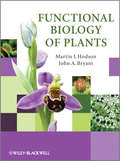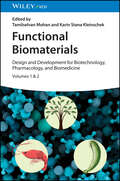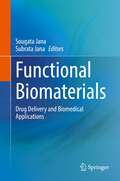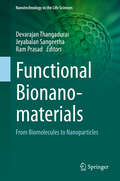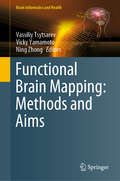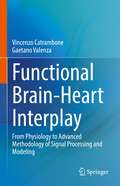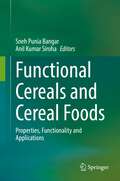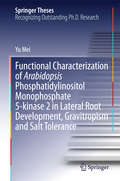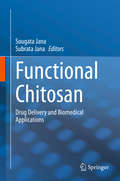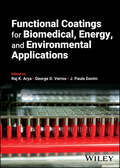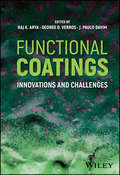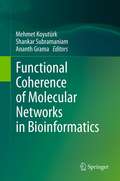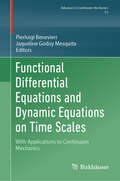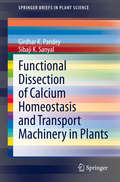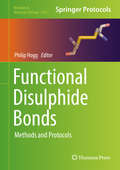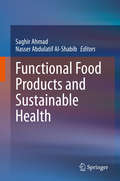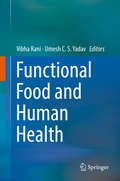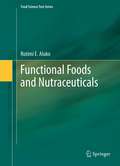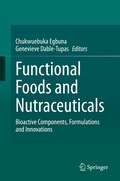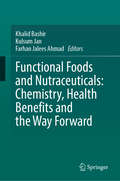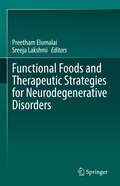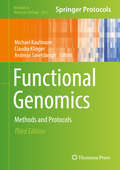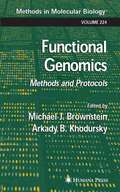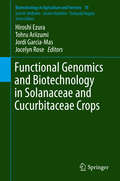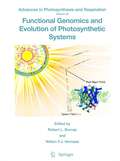- Table View
- List View
Functional Biology of Plants
by John A. Bryant Martin J. HodsonFunctional Biology of Plants provides students and researchers with a clearly written, well structured whole plant physiology text. Early in the text, it provides essential information on molecular and cellular processes so that the reader can understand how they are integrated into the development and function of the plant at whole-plant level. Thus, this beautifully illustrated book, presents a modern, applied integration of whole plant and molecular approaches to the study of plants. It is divided into four parts: Part 1: Genes and Cells, looks at the origins of plants, cell structure, biochemical processes and genes and development. Part 2: The Functioning Plant, describes the structure and function of roots, stems, leaves, flowers and seed and fruit development. Part 3: Interactions and Adaptations, examines environmental and biotic stresses and how plants adapt and acclimatise to these conditions. Part 4: Future Directions, illustrates the great importance of plant research by looking at some well chosen, topical examples such as GM crops, biomass and bio-fuels, loss of plant biodiversity and the question of how to feed the planet. Throughout the book there are text boxes to illustrate particular aspects of how humans make use of plants, and a comprehensive glossary proves invaluable to those coming to the subject from other areas of life science.
Functional Biomaterials: Design and Development for Biotechnology, Pharmacology, and Biomedicine, 2 Volumes
by Tamilselvan MohanA succinct handbook explaining interdisciplinary processing, methods, and applications of bio-based materials This book merges the two most important trends in biomaterials: functionalization and renewable chemistry. It covers a variety of biopolymers and various approaches for the transformation of these biopolymers into functional units. Sample topics covered by the two well-qualified authors include: Fundamental knowledge of biopolymers–natural ones, such as cellulose and other polysaccharides, and synthetic ones, such as polyethylene The origin, classifications, chemical nature, and isolation methods of specific biopolymers The different classical and modern approaches for the transformation of biopolymers into different shapes, ranging from thin films (model surfaces), to nanoparticles, to nanofibers, all the way to 3D scaffolds The morphology, structure, shape, thermal, electrical, and surface properties of biomaterialsThis all-inclusive reference guide, which covers fundamentals, methods, and applications alike, is a key resource for both students and practicing scientists involved in programs of study or disciplines that intersect with the field of biomaterials.
Functional Biomaterials: Drug Delivery and Biomedical Applications
by Sougata Jana Subrata JanaThis book explores in depth a wide range of functional biomaterials-based systems for drug, gene delivery, and biomedical aspects. The chapters cover newer technologies such as polymeric micelle, pH-responsive biomaterials, stimuli-responsive hydrogels, silk fibroin, inorganic biomaterials, synthetic biomaterials, 3D printed biomaterials, metallic biomaterials, ceramic and hybrid biomaterials. It also describes the theranostic approaches for cancer therapy, the biomaterials-based nanofibers scaffolds in tissue engineering, as well as the strategies applications of metallic biomaterials for the medical and dental prosthetic field. This newer and updated approach will be attractive for biomedical engineering students working on materials science in the development of novel drug delivery strategies. The book will be an important reference for researchers and professionals working on biomaterial research in the pharmaceutical and medical fields.
Functional Bionanomaterials: From Biomolecules to Nanoparticles (Nanotechnology in the Life Sciences)
by Jeyabalan Sangeetha Ram Prasad Devarajan ThangaduraiThis book focuses on the application of nanotechnology in medicine and drug delivery, including diagnosis and therapy. Nanomedicine can contribute to the development of a personalized medicine both for diagnosis and therapy. By interacting with biological molecules at nanoscale level, nanotechnology opens up an immense field of research and applications. Interactions between artificial molecular assemblies or nanodevices and biomolecules can be understood both in the extracellular medium and inside human cells. Operating at nanoscale allows exploitation of physical properties different from those observed at microscale, such as the volume to surface area ratio.A number of clinical applications of nanobiotechnology, such as disease diagnosis, target-specific drug delivery, and molecular imaging are being investigated. Some promising new products are also undergoing clinical trials. Such advanced applications of this approach to biological systems will undoubtedly transform the foundations of diagnosis, treatment, and prevention of disease in the future.Nanomedicine sales reached $16 billion in 2015, with a minimum of $3.8 billion in nanotechnology R&D being invested each year. Global funding for emerging nanotechnology increased by 45% per year in recent years, with product sales exceeding $1 trillion in 2013. As the nanomedicine industry continues to grow, it is expected to have a significant impact on the global economy.This book provides clear, colorful and simple illustrations, tables, and case studies to clearly convey the content to a general audience and reader. This book also discusses the development of nanobiomaterials from biogenic (biological sources) systems for healthcare and disease therapies. This book, therefore, is useful for researchers and academicians in the fields of nanotechnology, medicine, nano-biotechnology and pharmacology.
Functional Brain Mapping: Methods and Aims (Brain Informatics and Health)
by Ning Zhong Vicky Yamamoto Vassiliy TsytsarevThis book provides an essential overview of the broad range of functional brain imaging techniques, as well as neuroscientific methods suitable for various scientific tasks in fundamental and clinical neuroscience. It also shares information on novel methods in computational neuroscience, mathematical algorithms, image processing, and applications to neuroscience.The mammalian brain is a huge and complex network that consists of billions of neural and glial cells. Decoding how information is represented and processed by this neural network requires the ability to monitor the dynamics of large numbers of neurons at high temporal and spatial resolution over a large part of the brain. Functional brain optical imaging has seen more than thirty years of intensive development. Current light-using methods provide good sensitivity to functional changes through intrinsic contrast and are rapidly exploiting the growing availability of exogenous fluorescence probes. In addition, various types of functional brain optical imaging are now being used to reveal the brain’s microanatomy and physiology.
Functional Brain-Heart Interplay: From Physiology to Advanced Methodology of Signal Processing and Modeling
by Gaetano Valenza Vincenzo CatramboneThis monograph offers a cross-system exchange and cross-modality investigation into brain-heart interplay. Brain-Heart Interplay (BHI) is a highly interdisciplinary scientific topic, which spreads from the physiology of the Central/Autonomous Nervous Systems, especially Central Autonomic Network, to advanced signal processing and modeling for its activity quantification. Motivated by clinical evidence and supported by recent findings in neurophysiology, this monograph first explores the definition of basic Brain-Heart Interplay quantifiers, and then moves onto advanced methods for the assessment of health and disease states. Non-invasive use of brain monitoring techniques, including electroencephalogram and function Magnetic Resonance Imaging, will be described together with heartbeat dynamics monitoring through pulseoximeter and ECG signals. The audience of this book comprises especially of biomedical engineers and medical doctors with expertise in statistics and/or signal processing. Researchers in the fields of cardiology, neurology, psychiatry, and neuroscience in general may be interested as well.
Functional Cereals and Cereal Foods: Properties, Functionality and Applications
by Anil Kumar Siroha Sneh Punia BangarIn recent years, consumers are concentrating more on the health benefits of food in order to preserve a healthy lifestyle and therefore becoming more aware of the relationship between diet and disease. This has resulted in a gradual shift from animal-derived to plant-based meals. Functional foods have turned into one of the rapidly expanding areas of the food industry due to the increasing awareness of consumers working to prevent lethal diseases like cancer, diabetes mellitus and cardiovascular disease. Functional foods are seen as the food or food components that manifest efficiency in protecting from diseases and attaining a healthier lifestyle by administering additional benefits on human physiology and metabolic functions apart from basic nutritional requirements of the body. Cereals hold a prominent place in this new market. Cereals and cereal foods are important energy sources and many phytochemicals such as dietary fiber, resistant starch, vitamins, minerals, lignans, phytic acid and phenolic compounds that provide a variety of health benefits. Eating functional cereal foods is an easy method to increase nutrients associated with whole grains without changing eating habits. Functional Cereals and Cereal Foods: Properties, Functionality and Applications comprehensively covers the Chemistry and nutritional composition of functional cereals components, their functionality and therapeutic significance, current innovations and functional approaches in improving attributes and biofortification and quality improvement of cereal products. The different types of functional cereals and their unlimited opportunities for the production of functional foods are covered in full, including gluten-free products and all the newest cereal processing technologies. For researchers in search of a fully up-to-date look at functional cereal foods and technologies and their important place on the current market, this text provides a timely and comprehensive overview.
Functional Characterization of Arabidopsis Phosphatidylinositol Monophosphate 5-kinase 2 in Lateral Root Development, Gravitropism and Salt Tolerance
by Yu MeiThe functional characterization of a key enzyme in the phosphatidylinositol (PI) signaling pathway in the model plant Arabidopsis thaliana is the focus of the research summarised in this thesis. Moreover, a particular focus is the exploration of the biological functions of Arabidopsis phophatidylinositol monophosphate 5-kinase 2 (PIP5K2) which catalyzes the synthesis of phophatidylinositol (4,5) bisphosphate, the precursor of two important second messengers (inositol 1,4,5-trisphosphate and diacylglycerol). Through molecular and genetic approaches, the author isolated and characterized the expression pattern, physiological functions and the underlying mechanism of Arabidopsis PIP5K2. It is found that PIP5K2 is involved in regulating lateral root formation and root gravity response through modulating auxin accumulation and polar auxin transport and also plays a critical role in salt tolerance. These findings shed new light on the crosstalk between PI signaling and auxin response, both of which have crucial regulatory roles in plant development.
Functional Chitosan: Drug Delivery and Biomedical Applications
by Sougata Jana Subrata JanaThanks to their unique properties, chitosan and chitosan-based materials have numerous applications in the field of biomedicine, especially in drug delivery. This book examines biomedical applications of functional chitosan, exploring the various functions and applications in the development of chitosan-based biomaterials. It also describes the chemical structure of chitosan and discusses the relationship between their structure and functions, providing a theoretical basis for the design of biomaterials. Lastly, it reviews chemically modified and composite materials of chitin and chitosan derivatives for biomedical applications, such as tissue engineering, nanomedicine, drug delivery, and gene delivery.
Functional Coatings for Biomedical, Energy, and Environmental Applications
by J. Paulo Davim Raj K. Arya George D. VerrosUnderstand functional coatings and their role in three key industries of the future Functional coatings play a huge range of roles in industries from automotive to aerospace to electronic and beyond. They offer protection, performance enhancement, corrosion resistance, self-cleaning properties, and more. Recent developments in the field have allowed for ever more precise optimization of functional coatings, with the result that demand for these key tools is only likely to increase. Functional Coatings for Biomedical, Energy, and Environmental Applications offers a comprehensive overview of these coatings and their applications in three explosively productive industries. A team of expert contributors provides chapters analyzing the latest developments in this growing area of production, with a particular focus on the dynamic relationship between functional coatings and their many applications. The result is an interdisciplinary text which will serve as an essential resource for researchers and industry professionals worldwide. Readers will also find: Analysis of functional coatings for dental implants, pool boilers, solar cells, and many more Detailed discussion of coating properties including superhydrophobicity, self-cleaning, controlled drug release, and more Key contributions to the great environmental challenges of the twenty-first century This book is a must-own for researchers in chemistry, engineering, energy, materials science, and more, as well as for industry professionals working with coating and other aspects of research and development in biomedical, energy, or environmental industries.
Functional Coatings: Innovations and Challenges
by J. Paulo Davim Raj K. Arya George D. VerrosFUNCTIONAL COATINGS A must-own resource for understanding functional coatings and their revolutionary potential Functional coatings are those which provide not only the protection and performance enhancement of a conventional coating, but also offer additional properties tailored to meet the specific requirements of a given industry or application. They have applications in a huge range of sectors, including automotive, aerospace, healthcare, energy, and more. Coatings with properties like fire retardancy, antimicrobial properties, or controlled drug release have the potential to revolutionize entire industries. Functional Coatings offers a comprehensive resource for engineers and researchers looking to understand these coatings and the opportunities they provide. Beginning with an overview of the subject’s foundations and industrial significance, the book analyzes numerous coating methods and their properties, with a particular focus on anticorrosion coatings. The result is an indispensable resource for professionals in virtually any technological industry looking to understand the benefits of a cutting-edge toolkit. Functional Coatings readers will also find: Coverage of synthesis, durability, reproducibility, cost-effectiveness, specialized surface morphology, and environmental friendliness of each coating Detailed discussion of antimicrobial coatings, fire-retardant coatings, self-healing coatings, nanopowder coatings, coatings for marine applications, and many more Applications of additives, machine learning, and sophisticated characterizations, etc. as per industry requirements Functional Coatings is ideal for researchers, engineers, and industry professionals working with any area of technology where coatings have purchase.
Functional Coherence of Molecular Networks in Bioinformatics
by Ananth Grama Mehmet Koyutürk Shankar SubramaniamMolecular networks provide descriptions of the organization of various biological processes, including cellular signaling, metabolism, and genetic regulation. Knowledge on molecular networks is commonly used for systems level analysis of biological function; research and method development in this area has grown tremendously in the past few years. This book will provide a detailed review of existing knowledge on the functional characterization of biological networks. In 15 chapters authored by an international group of prolific systems biology and bioinformatics researchers, it will organize, conceptualize, and summarize the existing core of research results and computational methods on understanding biological function from a network perspective.
Functional Differential Equations and Dynamic Equations on Time Scales: With Applications to Continuum Mechanics (Advances in Mechanics and Mathematics #52)
by Pierluigi Benevieri Jaqueline Godoy MesquitaThis volume presents recent advances in the field of dynamic equations on time scales and functional differential equations, with a focus on how these topics can be used to describe phenomena in continuum mechanics. Chapters investigate important aspects of these equations, such as asymptotic behavior and the qualitative properties of their solutions. Specific topics covered include: Ulam stability for dynamic equations Generalized ordinary differential equations Singular control systems on time scales Bresse systems Functional Differential Equations and Dynamic Equations on Time Scales will be a valuable resource for graduate students and researchers who work in these areas.
Functional Dissection of Calcium Homeostasis and Transport Machinery in Plants (SpringerBriefs in Plant Science)
by Girdhar K. Pandey Sibaji K. SanyalThis book focuses on the significance and implications of Calcium (Ca2+) transport machinery in the plant cell in generating alternating Ca2+ levels and impacting the cell’s physiological, biochemical and developmental processes. In the following sections, the concept of Ca2+ homeostasis, Ca2+ signature, various Ca2+ transport protein families and conductance systems would be discussed in detail- elucidation of their functional characterization, structure, mechanism, sub-cellular localization and specific physiological roles in ensuring Ca2+ homeostasis. Also, the aspect of Ca2+ as a “signaling hub” –transducing distinct plant responses to diverse environmental stimuli, Ca2+ binding proteins, and the tools used in studying these proteins are explained in brief to paint a holistic picture of Ca2+ transport in plant systems. This has resulted in an elaborative literature account to serve as a staple by providing recent insights and advance knowledge surrounding genetic and molecular dissection of Ca2+homeostasis maintenance mechanisms and extant Ca2+ transport systems in plants.
Functional Disulphide Bonds: Methods and Protocols (Methods in Molecular Biology #1967)
by Philip HoggThis book describes the current techniques used to study functional disulphides and to exploit them for therapeutic outcomes. Beginning with how disulphide bonds are classified and how to study their evolution, the volume then continues with protein chemical, molecular dynamics, and force spectroscopy techniques used to identify functional disulphides and/or study their behavior, then focuses on techniques employed in the study of the factors that cleave and/or form disulphide bonds. Methods to study how particular functional disulphides are assayed in mouse and human tissues are likewise examined, amongst many other subjects. Written for the highly successful Methods in Molecular Biology series, chapters include introductions to their respective topics, lists of the necessary materials and reagents, step-by-step, readily reproducible laboratory protocols, and tips on troubleshooting and avoiding known pitfalls. Authoritative and practical, Functional Disulphide Bonds: Methods and Protocols serves as a vital guide to this evolving area of study.
Functional Food Products and Sustainable Health
by Saghir Ahmad Nasser Abdulatif Al-ShabibThere is a growing global awareness of the link between good diet and health. This fascinating book reviews various functional foods or nutraceuticals and the bio-active compounds they contain in order to identify the role of bioactive compounds such as nisin, micronutrients, and hydrocolloids in the diet in overall human health. It also provides up-to-date information on functional elements like antioxidants, dietary fibres, pre & probiotics, vitamins and mineral-enriched foods in the human diet. Consisting of fifteen chapters, the book offers a systematic review of the key factors in the preparation of functional foods from selected sources, and also describes the processing, preservation and packaging of a range of functional food products. This book is a valuable resource for students and researchers working in the field of food science, food technology, and nutrition, as well as for industry experts.
Functional Food and Human Health
by Vibha Rani Umesh C. YadavGlobal health and the increasing incidence of various diseases are a cause for concern, and doctors and scientists reason that the diet, food habits and lifestyle are contributing factors. Processed food has reduced the nutritional value of our diet, and although supplementing foods with various additives is considered an alternative, the long-term impact of this is not known. Many laboratories around the world are working to identify various nutritional components in our daily food and their effect on human health. These have been classified as Nutraceuticals or functional food, and they may have preventive and therapeutic effects in a number of pathologies associated with modern dietary habits and lifestyles. This book addresses various aspects of this issue, revitalizing the discussion and consolidating the latest research on nutritional and functional food and their effects in in-vitro, in-vivo and human clinical studies.
Functional Foods and Nutraceuticals
by Rotimi E. Aluko"Functional food or medicinal food is any fresh or processed food claimed to have a health-promoting and/or disease-preventing property beyond the basic nutritional function of supplying nutrients, although there is no consensus on an exact definition of the term. This is an emerging field in food science, in which such foods are usually accompanied by health claims for marketing purposes, such as a company's 'cereal is a significant source of fiber. Studies have shown that an increased amount of fiber in one's diet can decrease the risk of certain types of cancer in individuals.' Functional foods are sometimes called nutraceuticals, a portmanteau of nutrition and pharmaceutical, and can include food that has been genetically modified. The general category includes processed food made from functional food ingredients, or fortified with health-promoting additives, like "vitamin-enriched" products, and also fresh foods (e.g., vegetables) that have specific claims attached. Fermented foods with live cultures are often also considered to be functional foods with probiotic benefits."
Functional Foods and Nutraceuticals: Bioactive Components, Formulations and Innovations
by Chukwuebuka Egbuna Genevieve Dable-TupasFunctional foods and nutraceuticals are food products that naturally offer or have been modified to offer additional health benefits beyond basic nutrition. As such products have surged in popularity in recent years, it is crucial that researchers and manufacturers understand the concepts underpinning functional foods and the opportunity they represent to improve human health, reduce healthcare costs, and support economic development worldwide.Functional Foods and Nutraceuticals: Bioactive Components, Formulations and Innovations presents a guide to functional foods from experienced professionals in key institutions around the world. The text provides background information on the health benefits, bioavailability, and safety measurements of functional foods and nutraceuticals. Subsequent chapters detail the bioactive components in functional foods responsible for these health benefits, as well as the different formulations of these products and recent innovations spurred by consumer demands. Authors emphasize product development for increased marketability, taking into account safety issues associated with functional food adulteration and solutions to be found in GMP adherence. Various food preservation methods aimed at enhancing the quality and shelf life of functional food are also highlighted. Functional Foods and Nutraceuticals: Bioactive Components, Formulations and Innovations is the first of its kind, designed to be useful to students, teachers, nutritionists, food scientists, food technologists and public health regulators alike.
Functional Foods and Nutraceuticals: Chemistry, Health Benefits and the Way Forward
by Farhan Jalees Ahmad Khalid Bashir Kulsum JanProgress in understanding the association between the health benefits of foods, prevention of diseases and immunity enhancers has led researchers to focus on functional components of foods. Considerable evidence from epidemiological, clinical and laboratory studies have shown numerous functional components in foods which may enhance immunity and help in preventing various lifestyle diseases. This book specifically documents the therapeutic roles of functional foods and their ingredients and explains their bioavailability and accessibility. Functional Foods and Nutraceuticals: Chemistry, Health Benefits and the Way Forward addresses recent advances and future prospects of health benefits in different functional foods. It also provides a thorough understanding of the bioavailability of fortificants, their mechanisms of action, extraction techniques, effects of processing, nutraceutical and nanomaterial development and legislation. The book also delivers up-to-date information regarding the techniques of fortification, their bio-accessibility and trends along with the application of nanotechnology for the development of functional foods. This text serves as a multidisciplinary source appropriate for researchers from food science and technology, biotechnology, pharmaceutical and allied sciences, Provides recent advances in extraction of phytochemicalsExplores the role of Nutraceuticals as immunity boosters and in combatting lifestyle diseases
Functional Foods and Therapeutic Strategies for Neurodegenerative Disorders
by Preetham Elumalai Sreeja LakshmiThis book provides a comprehensive summary of the latest knowledge regarding functional foods and new therapeutic strategies for neurodegenerative disorders through explaining specific mechanisms for natural remedies and functional foods as well as alternative treatment and supplementary approaches for neurodegenerative diseases. Many relevant topics are covered, including role of prebiotics, recent applications for dietary polyphenols, marine bioactive compounds for neuro disorders, and age-related disorders. The roles of various remedies and functional foods are explained for various types of diseases, and the book also integrates the role of functional foods and remedies to work with the current therapeutics that are taking place. In parallel, the information presented through this book will also stimulate current status of leading contemporary methods for prohylactic and diagnostic practices, comprising nanoparticles, biomarkers, in silico techniques, and CRISPR-mediated genome editing–based therapy. The book will be essential reading for students and researchers with an interest in natural medicine, drug development, and food therapeutic strategies. In presenting new results and approaches and identifying areas for future research, it will also be of benefit for specialists in the field.
Functional Genomics
by Michael Kaufmann Claudia Klinger Andreas SavelsberghOver the last decade Life Science has undergone an accelerated evolution, culminating in the -omics era characterized by the development of a multitude of high throughput methods that are becoming more routinely applied in biochemistry labs. In Functional Genomics: Methods and Protocols, Second Edition expert researchers in the field detail many of the methods which are now commonly used for studies in the life sciences focusing on the dynamic aspects of the transcriptome, proteome and metabolome, respectively. Written in the highly successful Methods in Molecular Biology(tm) series format, chapters include introductions to their respective topics, lists of the necessary materials and reagents, step-by-step, readily reproducible laboratory protocols, and key tips on troubleshooting and avoiding known pitfalls. Authoritative and practical, Functional Genomics: Methods and Protocols, Second Edition seeks to aid scientists in establishing or extending technologies and techniques in their laboratories.
Functional Genomics
by Arkady Khodursky Michael J. BrownsteinThis collection of robust, readily reproducible methods for microarray-based studies includes expert guidance in the optimal data analysis and informatics. On the methods side are proven techniques for monitoring subcellular RNA localization en masse, for mapping chromosomes at the resolution of a single gene, and for surveying the steady-state genome-wide distribution of DNA binding proteins in vivo. For those workers dealing with massive data sets, the book discusses the methodological aspects of data analysis and informatics in the design of microarray experiments, the choice of test statistic, and the assessment of observational significance, data reduction, and clustering.
Functional Genomics and Biotechnology in Solanaceae and Cucurbitaceae Crops
by Hiroshi Ezura Tohru Ariizumi Jordi Garcia-Mas Jocelyn RoseThis volume summarizes recent technological advances in the design and engineering of Solanaceae and Cucurbitaceae crops. It begins with contributions on the tomato and melon genome sequence, databases for Solanaceae and Cucurbitaceae research, DNA markers in the breeding of the two families, and mutant resources and TILLING platforms in tomato research. Subsequent chapters address the use of molecular techniques for the modification of important breeding traits, such as tomato fruit set, growth, ripening, and sugar accumulation, as well as disease and insect resistance in melons. The volume closes with chapters on genome editing using artificial nucleases as a future breeding tool, and on the development of an in silico crop design system. It offers a valuable resource for plant breeders, molecular biologists, and agronomists.
Functional Genomics and Evolution of Photosynthetic Systems
by Robert Burnap Wim VermaasNew possibilities have been brought about by the stunning number of genomic sequences becoming available for photosynthetic organisms. This new world of whole genome sequence data spans the phyla from photosynthetic microbes to algae to higher plants. These whole genome projects are intrinsically interesting, but also inform the variety of other molecular sequence databases including the recent 'meta-genomic' sequencing efforts that analyze entire communities of organisms. As impressive as they are, are obviously only the beginning of the effort to decipher the biological meaning encoded within them. This book aims to highlight progress in this direction. This book aims toward a genome-level understanding of the structure, function, and evolution of photosynthetic systems and the advantages accrued from the availability of phyletically diverse sets of gene sequences for the major components of the photosynthetic apparatus. While not meant to be fully comprehensive in terms of the topics covered, it does provide detailed views of specific cases and thereby illustrates important new directions that are being taken in this fast-moving field--a field that involves the integration of bioinformatics, molecular biology, physiology, and ecology.
